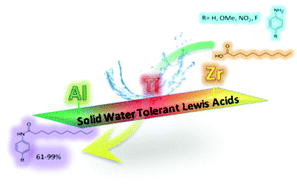Lewis acidity quantification and catalytic activity of Ti, Zr and Al-supported mesoporous silica†
Abstract
Water-tolerant supported Lewis acids are actively sought after, in particular to address the challenging direct amidation reaction. To this aim, a versatile and easy synthesis of large pore silica materials with supported Ti-, Al-, Zr-Lewis acids, using acetyl acetonate as a metal-stabilizing agent, was accomplished. The formation of bulk metal oxides was not observed, even at high concentrations of metal species. The Lewis acidity was demonstrated using quantitative and qualitative titration techniques using a series of Hammett indicators, such as butter yellow, phenylazodiphenylphosphine and dicinnamalacetone. The optimal concentration of metals corresponding to the highest Lewis acidity of solids was found to be 4% for Al-SBA-15, 12–15% for Ti-SBA-15 and 7% for Zr-SBA-15 materials. The water-tolerance of the supported metal centers was explored by a pyridine adsorption-FTIR study before and after water addition. The metalated materials were used as water-tolerant heterogeneous catalysts for the amidation of electron-poor and bulky amines, such as substituted anilines and morpholine, obtaining 59–99% yield of the corresponding amides.

- This article is part of the themed collection: CSC100: Celebrating Canadian Chemistry


 Please wait while we load your content...
Please wait while we load your content...